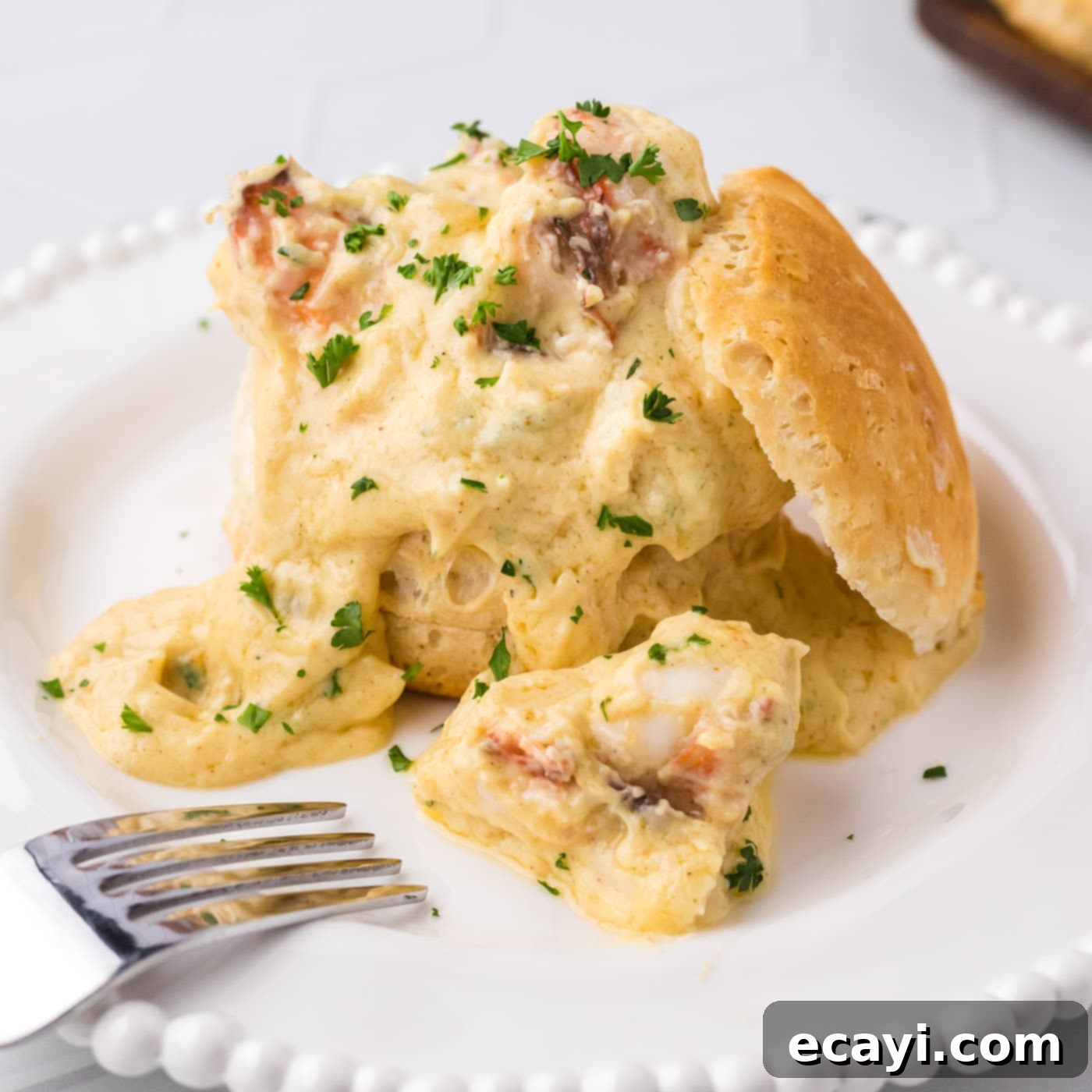Decadent Lobster Newburg: A Timeless Recipe for an Elegant Seafood Masterpiece
Prepare to elevate your dining experience with this exquisite Lobster Newburg recipe. Featuring generous chunks of succulent, buttery lobster tails enveloped in a rich, smooth, and utterly luxurious cream sauce, this dish is designed to be the undisputed highlight of any meal. Its complex yet harmonious flavors make it a truly decadent and unforgettable classic.
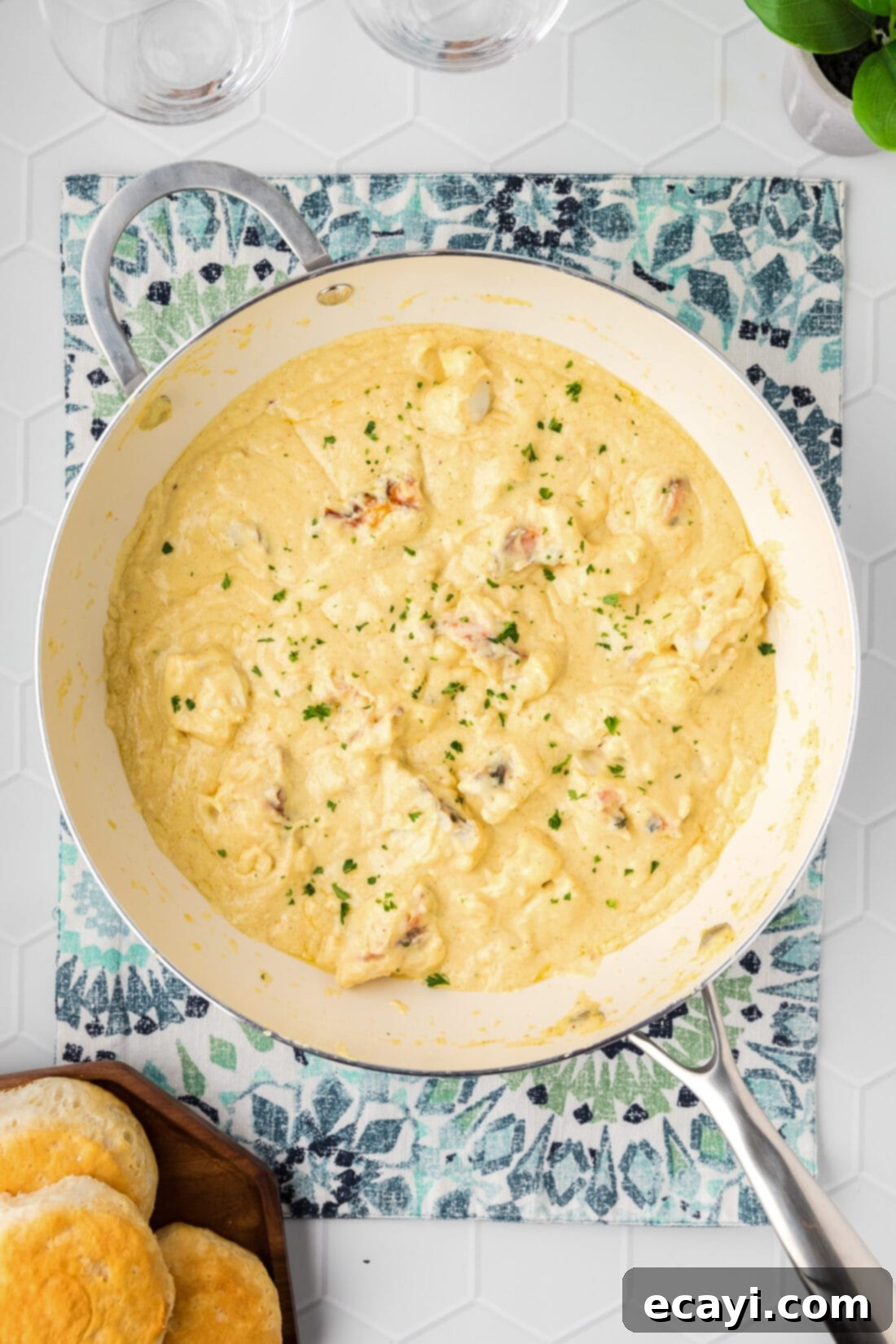
Why This Elegant Lobster Newburg Recipe Stands Out
This Lobster Newburg isn’t just a dish; it’s a celebration of fine dining made accessible in your own kitchen. What makes this recipe truly special is its perfect balance of richness, creamy texture, and the tender, sweet flavor of fresh lobster meat. Each spoonful delivers a luxurious experience, making it a beloved classic in the world of seafood cuisine.
Often compared to Lobster Thermidor due to its decadent creamy sauce, Lobster Newburg offers a distinct profile and presentation. While both are overflowing with incredible flavor, Newburg distinguishes itself with a sauce that is silkier and more focused on the pure essence of lobster and a delicate, fortified cream base, without the gratinéed cheese topping often found in Thermidor. If you appreciate the sophisticated flavors of Thermidor, you will undoubtedly fall in love with the refined elegance of Lobster Newburg.
The sauce in this Lobster Newburg recipe is meticulously crafted and elevated with a touch of Cognac and velvety egg yolks, which contribute to its depth and unparalleled smoothness. This makes it an ideal choice for pairing with a variety of light, flaky vehicles such as puff pastry shells, crisp toast points, delicate crackers, or warm, fluffy biscuits, making it the perfect showstopper for your next dinner party or a romantic evening at home. It’s an indulgence that promises to impress.
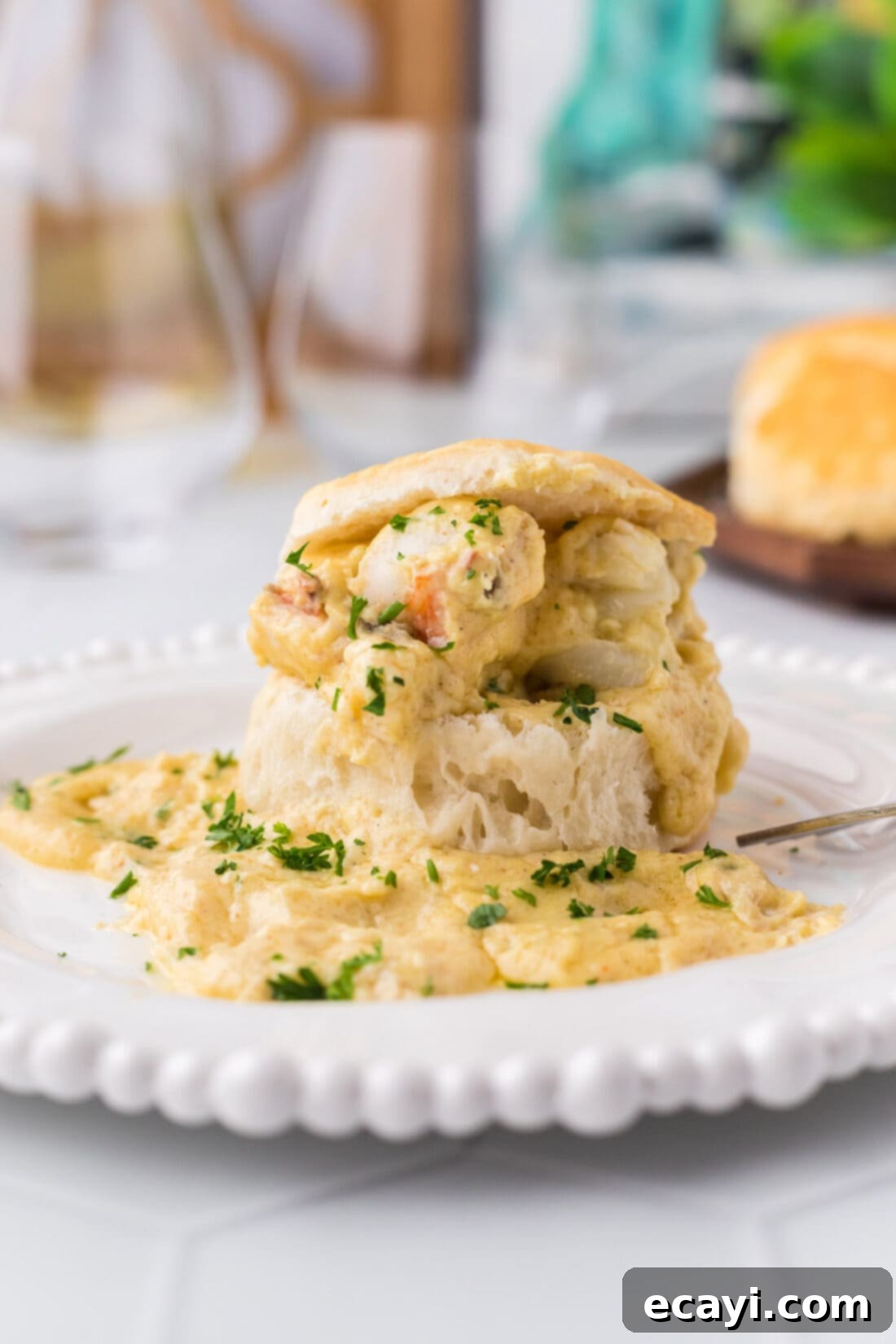
Essential Ingredients for Your Lobster Newburg
Creating an exceptional Lobster Newburg begins with selecting the finest ingredients. For precise measurements, detailed instructions, and a printable version of this recipe, please refer to the comprehensive recipe card located at the end of this post.
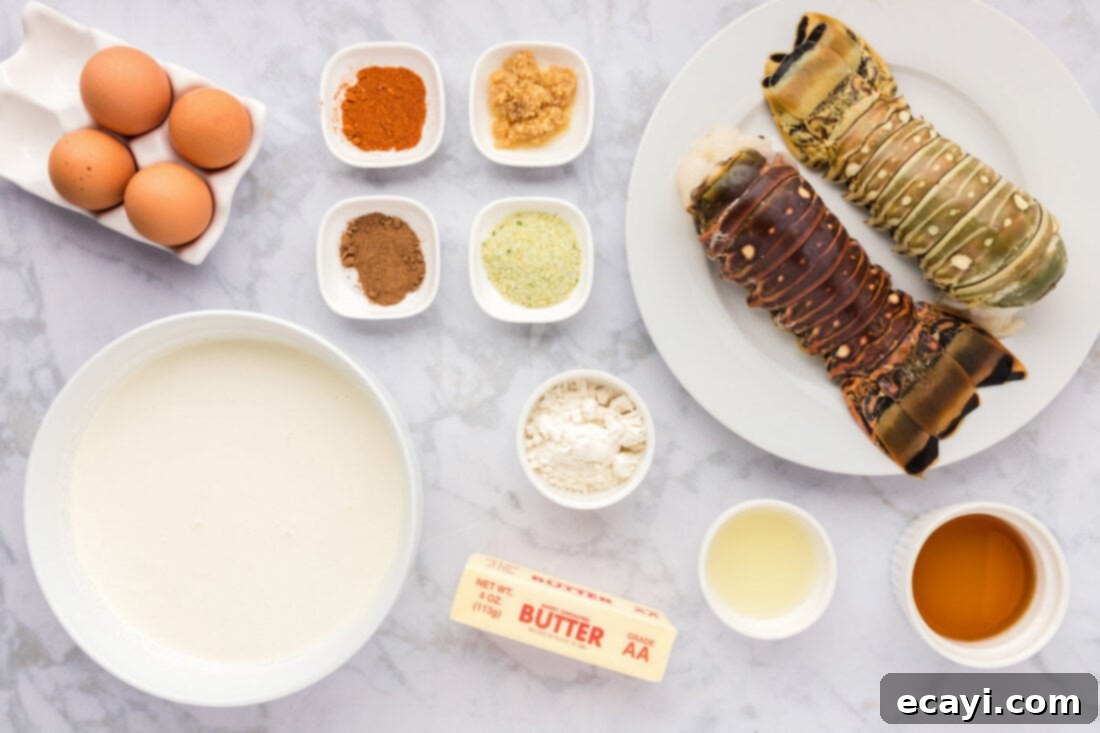
Ingredient Information and Expert Substitution Suggestions
Crafting the perfect Lobster Newburg relies on understanding each ingredient and how it contributes to the overall flavor and texture. Here’s a detailed guide to help you achieve the best results, along with smart substitution ideas.
LOBSTER: The star of this dish! For the most exquisite flavor and texture, we highly recommend using high-quality cold-water lobster tails, such as those from Maine or Canada. These tend to have sweeter, more tender meat. You can prepare your lobster using our detailed steamed lobster tail recipe, or opt for your preferred cooking method, whether it’s boiling or broiling. The key is to cook the lobster just until it’s opaque and firm, but still tender, to prevent it from becoming rubbery. If using frozen lobster tails, ensure they are fully thawed in the refrigerator overnight before cooking.
COGNAC: This ingredient is a hallmark of traditional Lobster Newburg, lending a sophisticated depth and nuanced aroma to the sauce. The subtle notes of fruit and oak from the Cognac beautifully complement the sweetness of the lobster. While Cognac is traditional, you have several excellent options if you prefer not to use it or don’t have it on hand:
- Brandy: A close cousin to Cognac, brandy offers a similar flavor profile and will work wonderfully as a direct substitute.
- Dry Sherry: For a slightly different, perhaps nuttier, undertone, dry sherry can be an excellent choice.
- White Wine: A dry white wine, like Chardonnay or Sauvignon Blanc, can provide acidity and a lighter fruitiness.
- Seafood Stock: If you prefer a non-alcoholic version, a good quality seafood stock will provide savory depth without the alcohol. You might want to add a tiny splash of lemon juice at the end to brighten the flavors, as the alcohol also contributes a certain zing.
- Omission: While the Cognac adds a distinct layer of complexity, you can technically omit it entirely, though the sauce will have a slightly less robust character.
SAUCE BASE (Heavy Cream & Thickener): The luscious cream sauce is what truly defines Lobster Newburg. It should be rich, velvety, and smooth, with just the right thickness to cling to the lobster chunks. Here are some pointers:
- Heavy Whipping Cream: This is the foundation of our decadent sauce. Its high fat content ensures a rich, stable, and incredibly smooth consistency. Using anything lighter will compromise the luxurious texture and flavor.
- Adjusting Thickness: The sauce mixture should be slightly thickened after cooking. If you find it’s too thick for your liking, you can easily thin it with a little extra heavy cream or whole milk, added gradually until the desired consistency is achieved. Conversely, if it’s too thin, you may need a tiny bit more flour (mixed with a small amount of cold water or cream to create a slurry before adding to prevent lumps) or cook it gently for a few more minutes to allow it to reduce slightly.
- Calorie-Conscious Option: If you’re looking to reduce the calorie count, you can replace the heavy cream with whole milk. Be aware that this substitution will result in a noticeably thinner sauce, as whole milk has a lower fat content. To compensate, you may need to increase the amount of all-purpose flour slightly to achieve a similar thickness. However, the overall richness and mouthfeel will differ.
OTHER KEY FLAVORINGS:
- Butter: Provides the initial richness for the roux and carries the flavors. Use unsalted butter to control the saltiness.
- Minced Garlic & Garlic Salt: Infuse the sauce with aromatic depth. The garlic salt adds both savory flavor and seasoning.
- Nutmeg: A pinch of freshly grated nutmeg is a classic addition to cream sauces, lending a subtle warmth and aromatic complexity that pairs beautifully with seafood. Don’t skip it!
- Cayenne Pepper: While it may seem like a generous amount, the cayenne pepper provides a gentle warmth and a hint of spice that cuts through the richness of the cream without making the dish overtly hot. The heavy cream itself drastically mellows the heat. It’s a key ingredient for balance.
- Lemon Juice: A squeeze of fresh lemon juice at the end is crucial. It brightens all the flavors, adds a touch of acidity, and prevents the sauce from tasting overly heavy.
How to Make This Unforgettable Lobster Newburg
These step-by-step photos and detailed instructions are provided to help you visualize each stage of making this incredible recipe. For a convenient printable version, complete with precise measurements and comprehensive instructions, you can Jump to Recipe at the bottom of this post.
- Prepare the Lobster: Begin by cooking your lobster tails. You can follow our straightforward steamed lobster tail instructions for perfectly cooked, tender results. Once cooked, allow the lobster to cool slightly, then remove the meat from the shells and cut it into luscious, bite-sized chunks. Set aside.
- Prepare Egg Yolk Mixture: In a measuring cup or small bowl, add the egg yolks. Incorporate 2 tablespoons of the heavy cream into the egg yolks and whisk vigorously with a fork until the mixture is smooth and well combined. This is a crucial step for preventing the eggs from scrambling when they are added to the hot sauce later.
- Melt Butter for the Roux: In a large, heavy-bottomed skillet (this type of skillet helps distribute heat evenly and prevents scorching) over medium-high heat, melt the butter. Ensure it’s fully melted and slightly shimmering, but not browned.
- Create the Roux Base: Add the minced garlic to the melted butter and sauté for about 1 minute, until it becomes fragrant. Be careful not to let the garlic burn. Immediately sprinkle in the all-purpose flour and stir continuously with a whisk or wooden spoon for another minute or two. This step creates a roux, which will thicken the sauce and help to remove any raw flour taste.
- Season the Roux: Add the garlic salt to the butter-flour mixture and stir well to ensure it is evenly incorporated.
- Incorporate Cream: Gradually pour the remaining heavy cream into the skillet, whisking constantly to prevent lumps from forming. Bring the mixture to a gentle boil, then immediately reduce the heat to low. The sauce should begin to thicken slightly.
- Temper the Egg Yolks: This step is vital for a smooth, unbroken sauce. While continuously whisking the hot cream mixture in the skillet, slowly drizzle the prepared egg yolk and cream mixture into the pan in a thin stream. The constant whisking and slow addition gradually raise the temperature of the egg yolks without cooking them too quickly, preventing them from scrambling and instead creating a beautifully emulsified, silken sauce.
- Add Flavor Enhancers: Whisk in the Cognac (or your chosen substitute), nutmeg, cayenne pepper, and fresh lemon juice. Continue whisking gently for another minute to allow the flavors to meld and the alcohol to cook off slightly.
- Fold in Lobster: Gently add the cooked lobster chunks to the creamy sauce. Stir carefully to ensure the lobster is thoroughly coated and heated through, but avoid over-mixing, which could break up the delicate lobster meat.
- Serve Immediately: Your decadent Lobster Newburg is now ready to be enjoyed! Serve it warm, either alone in a shallow dish, or elegantly over warm biscuits, crisp toast points, or delicate flaky pastry shells.
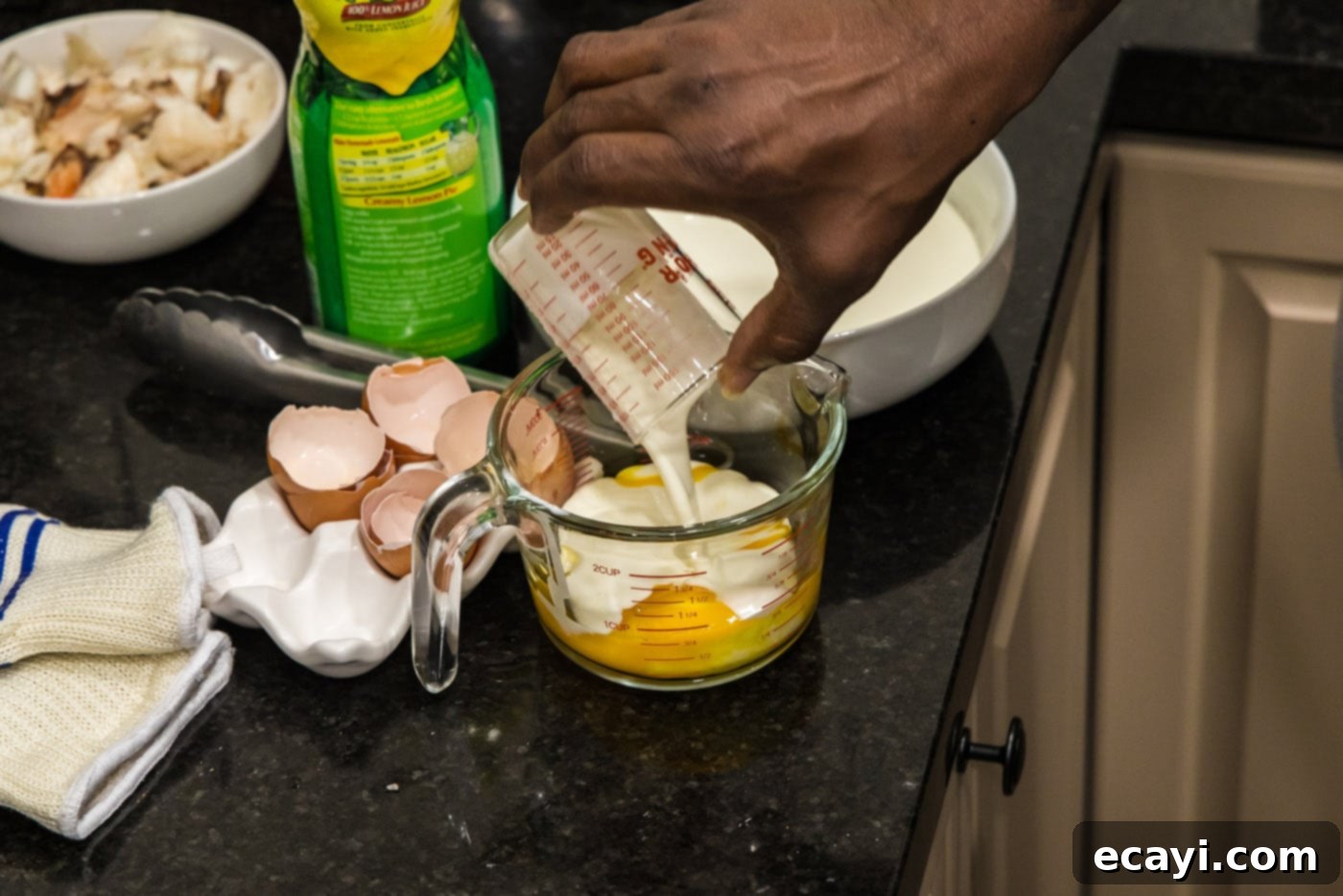
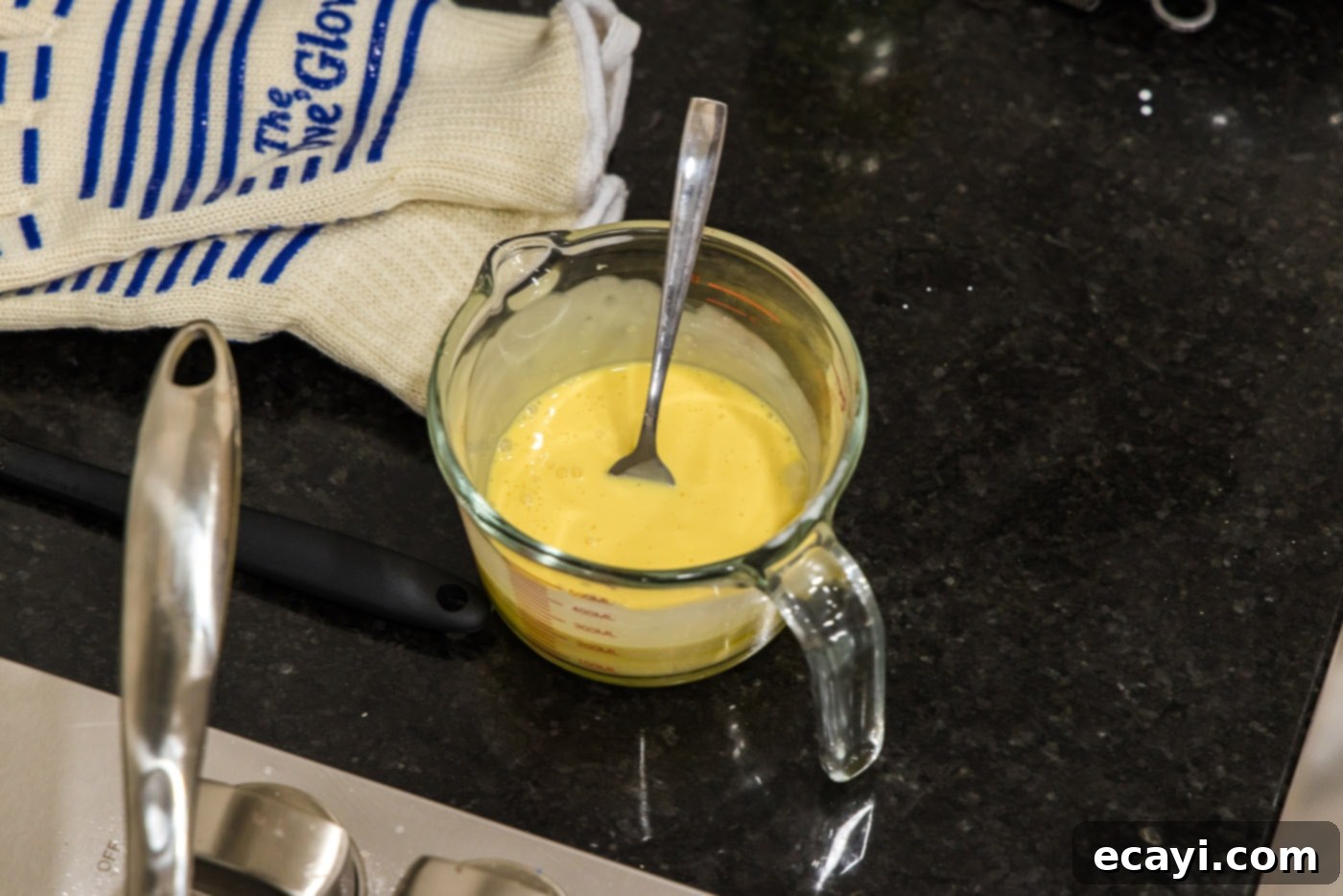
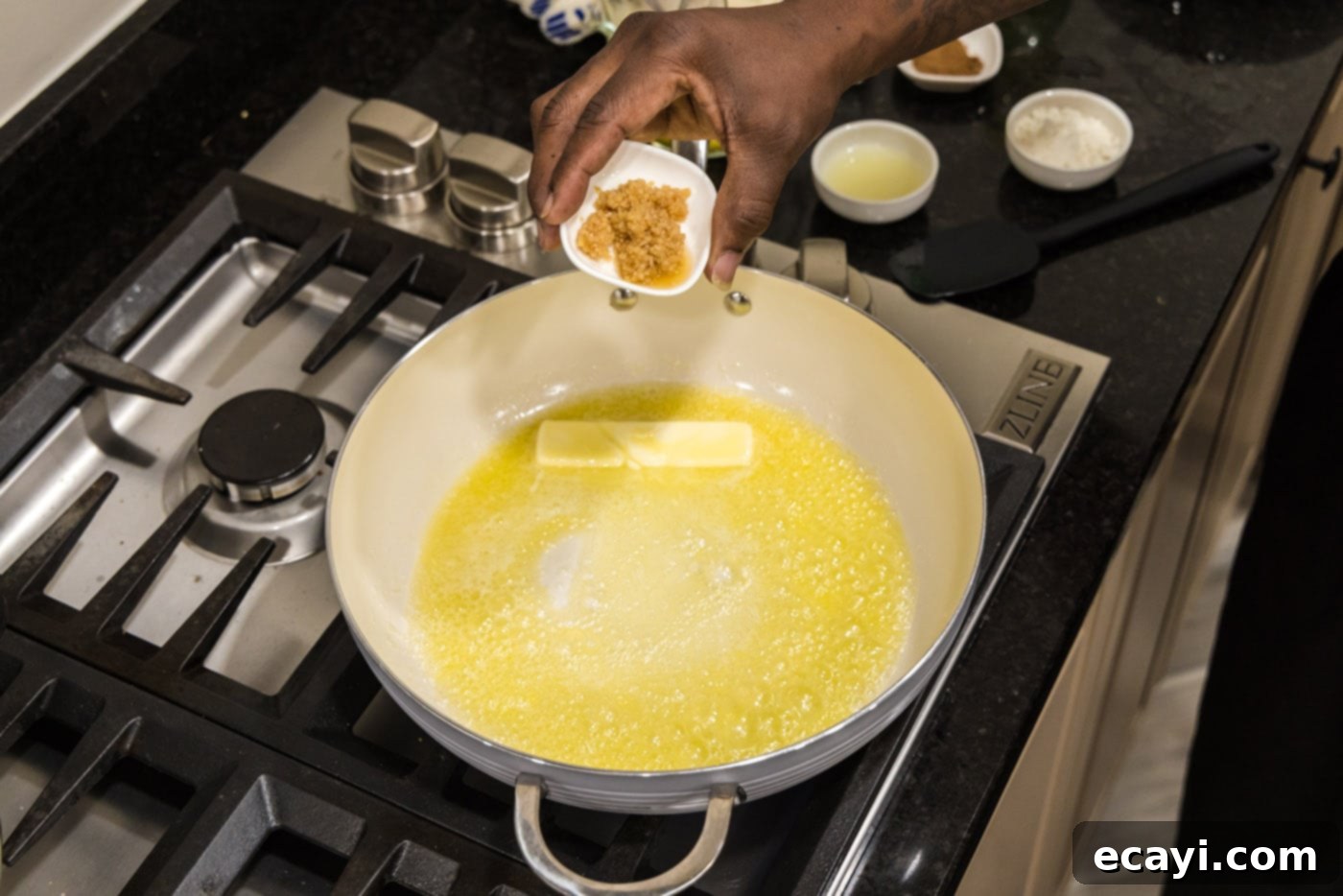
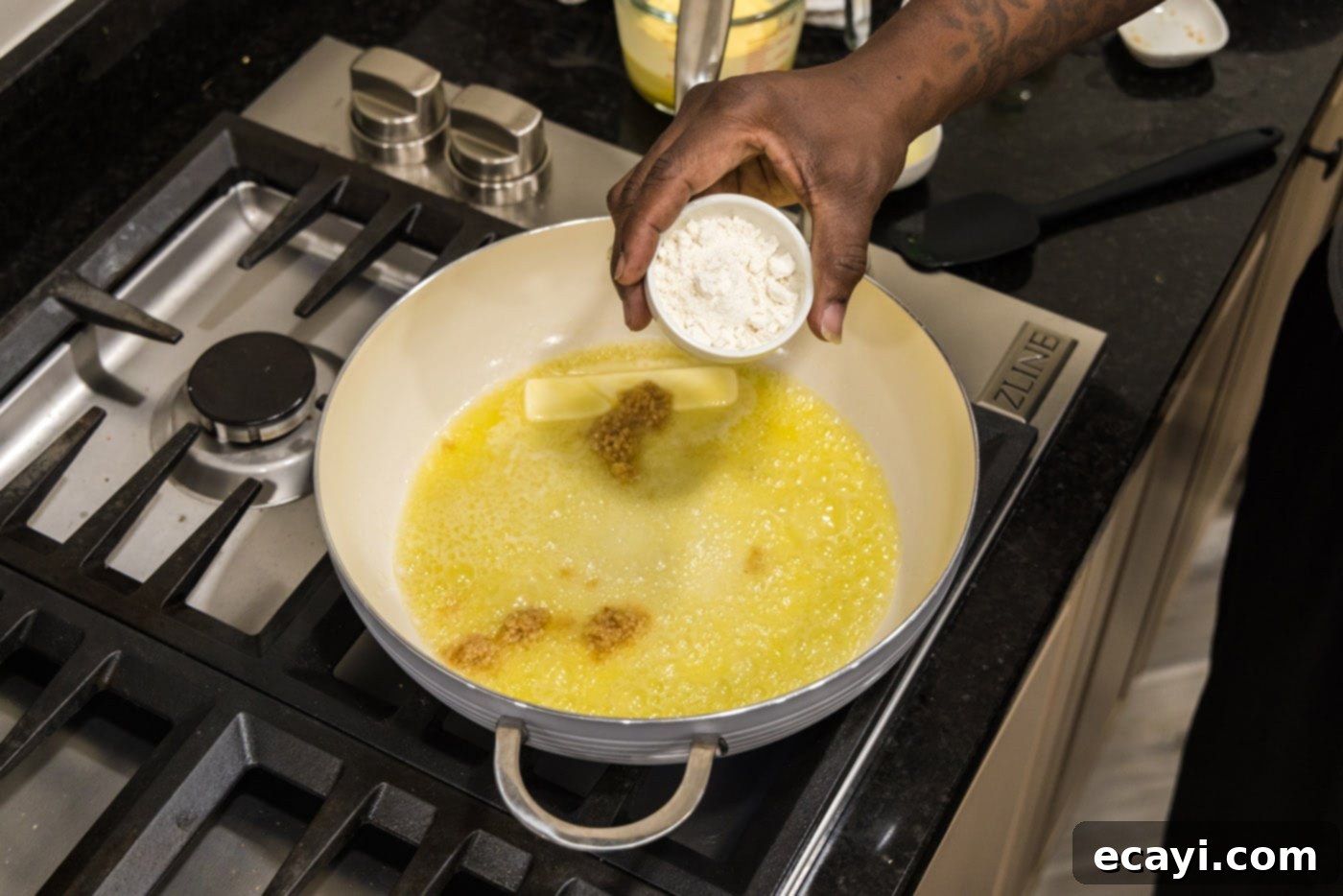
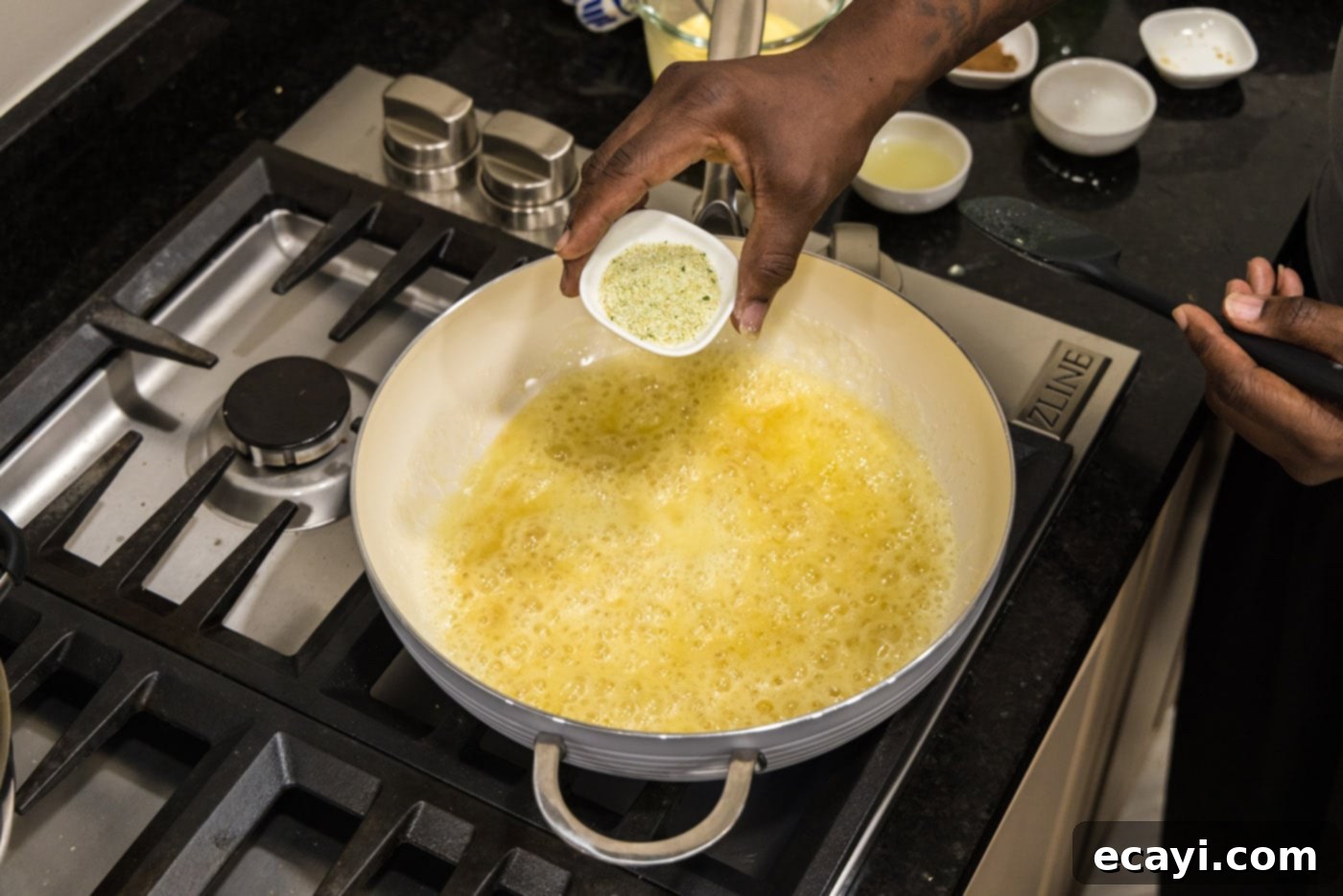
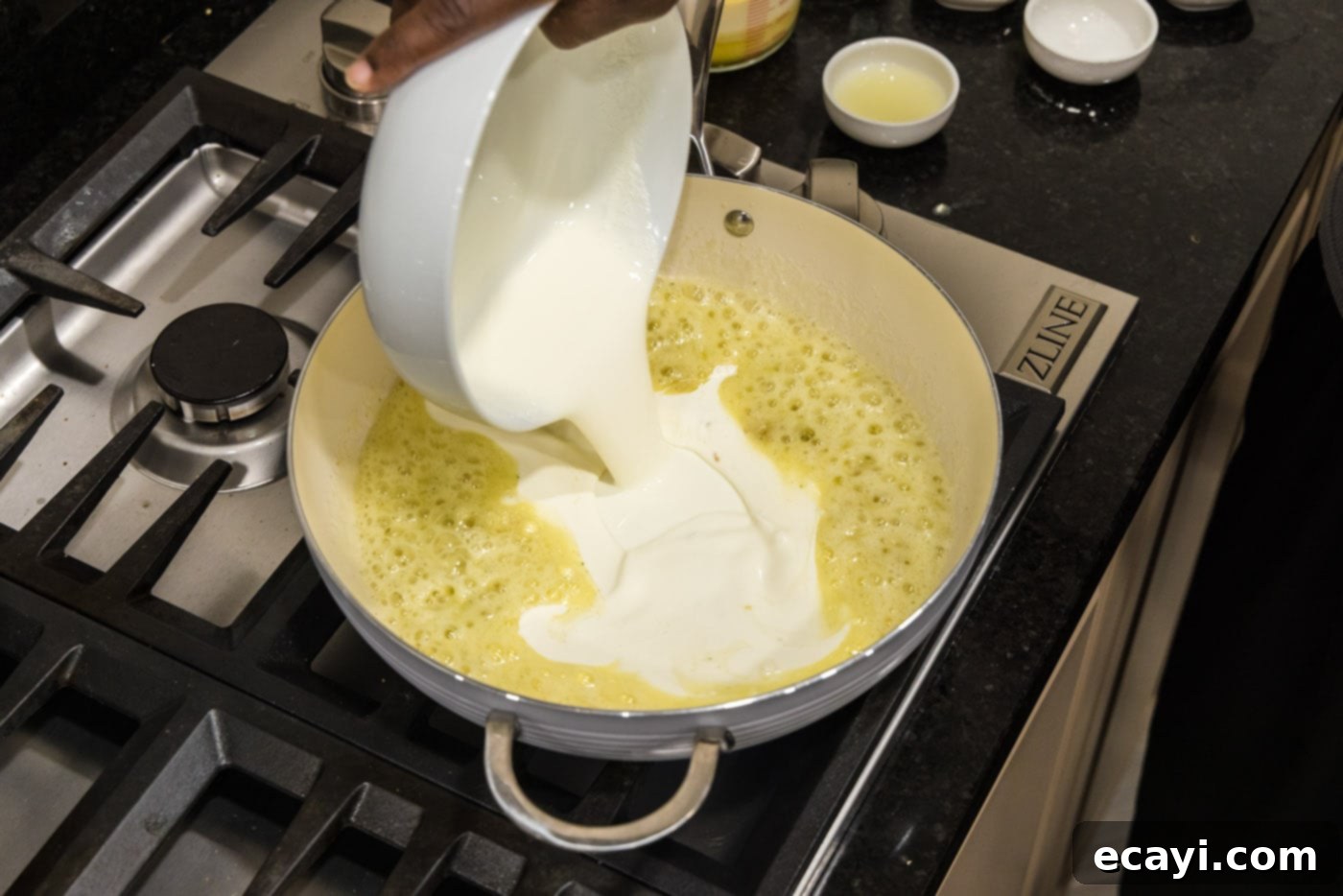
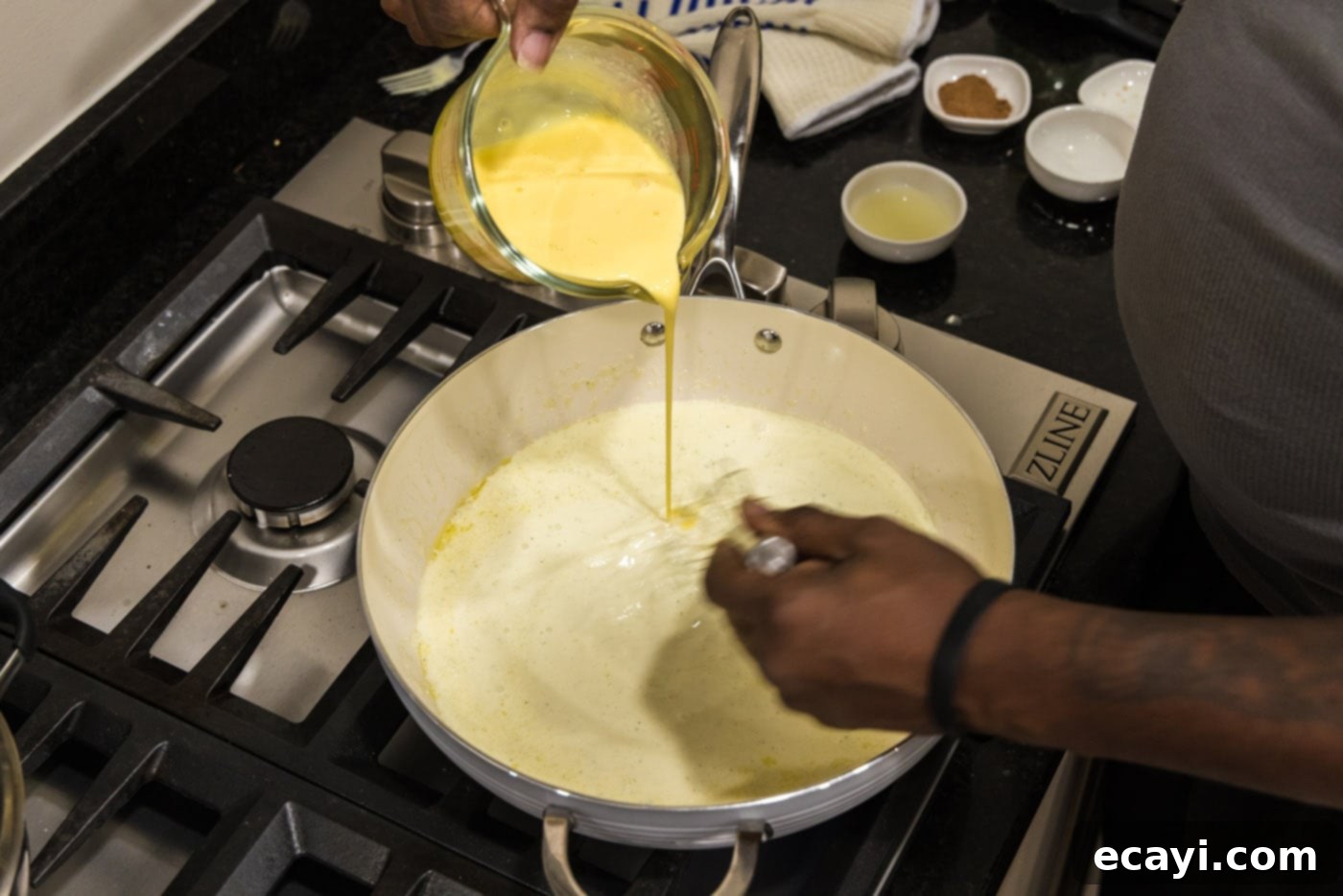
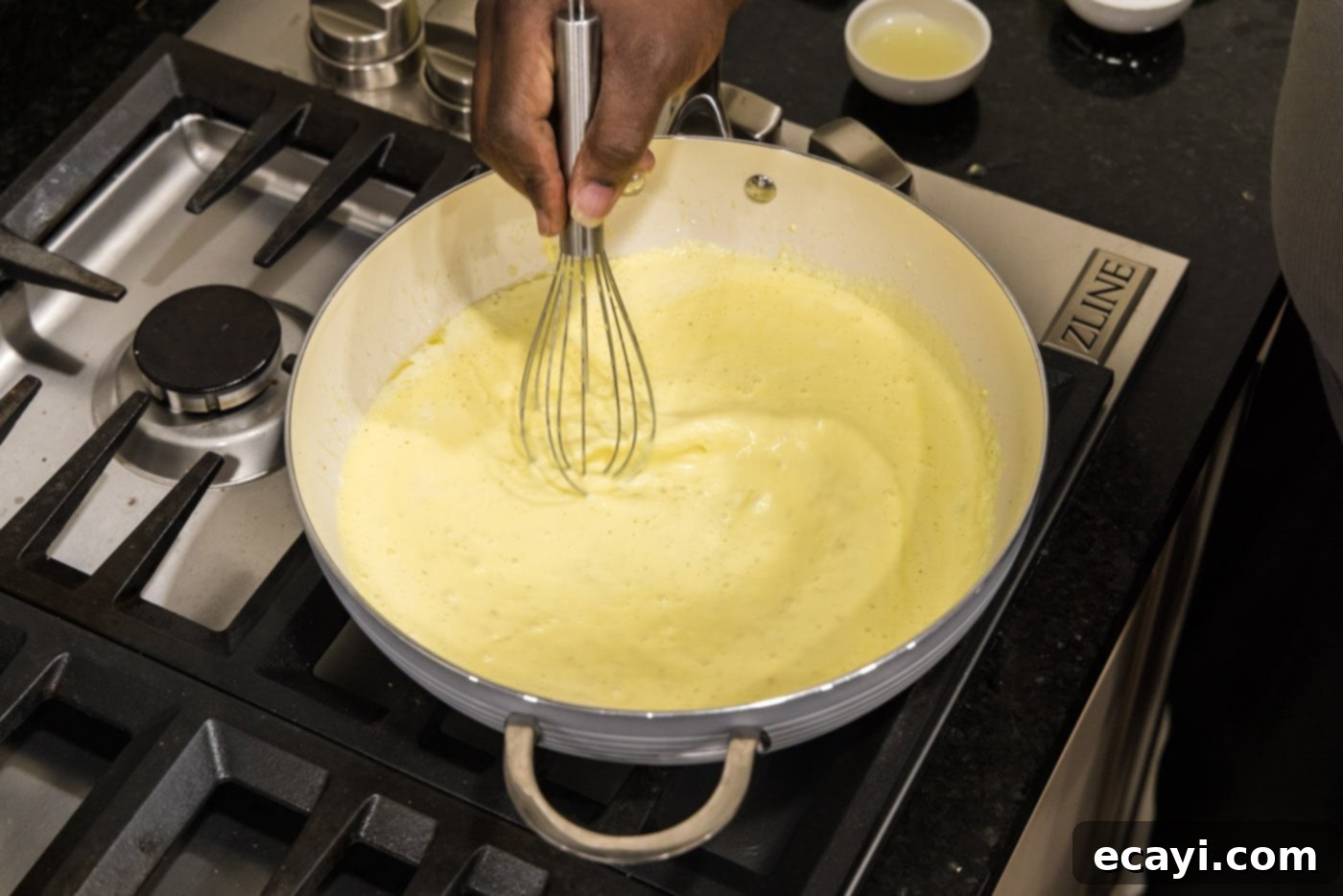
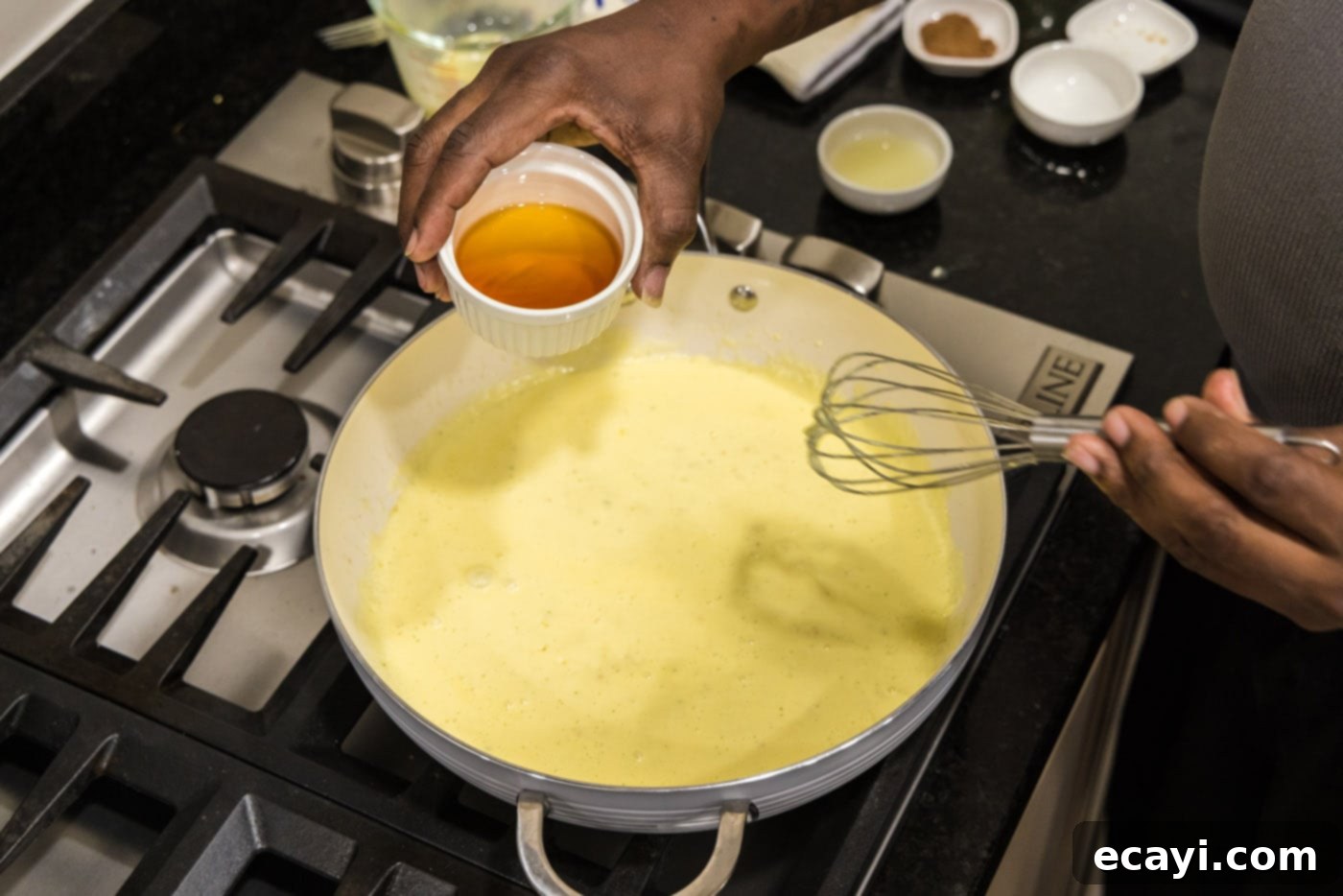
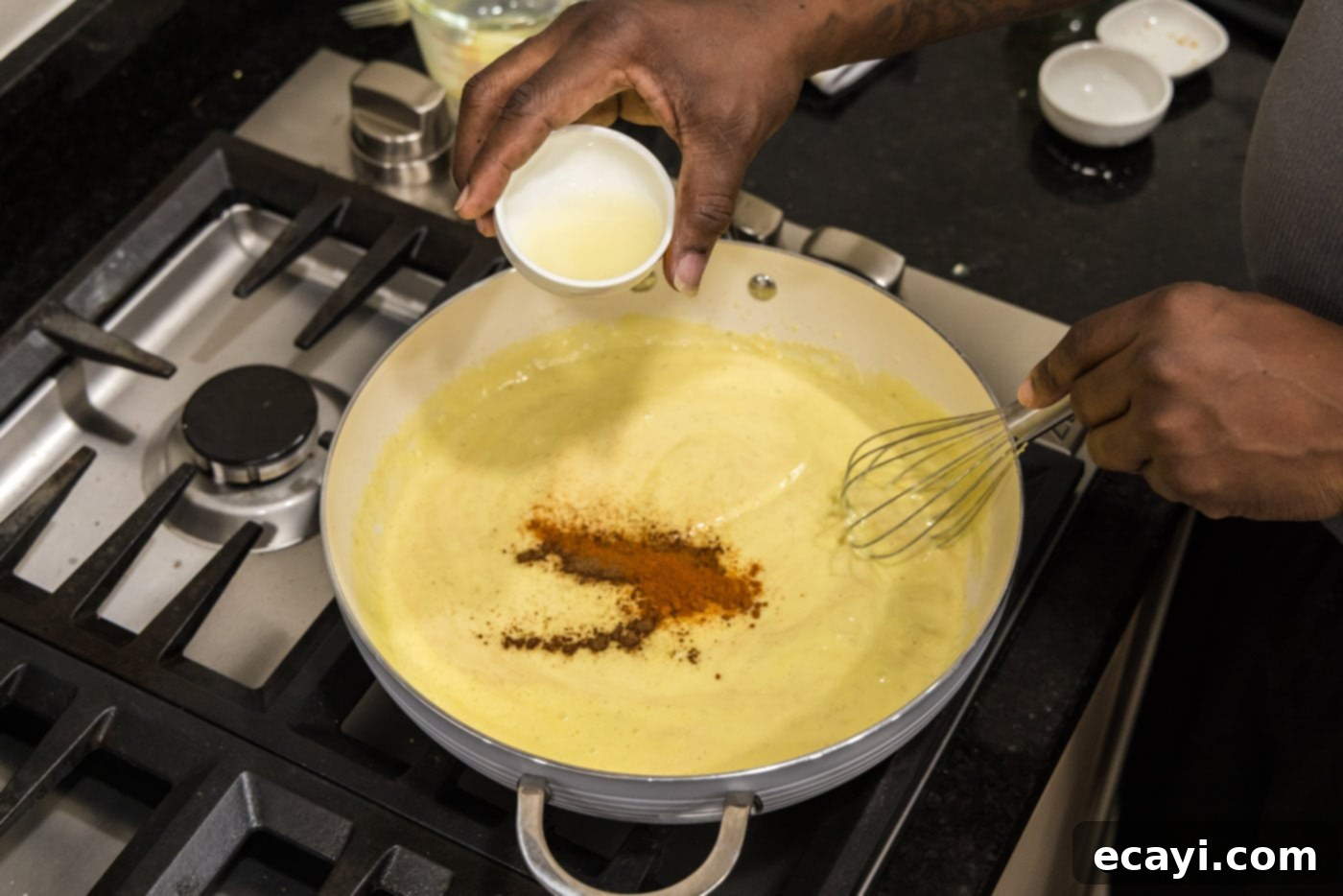
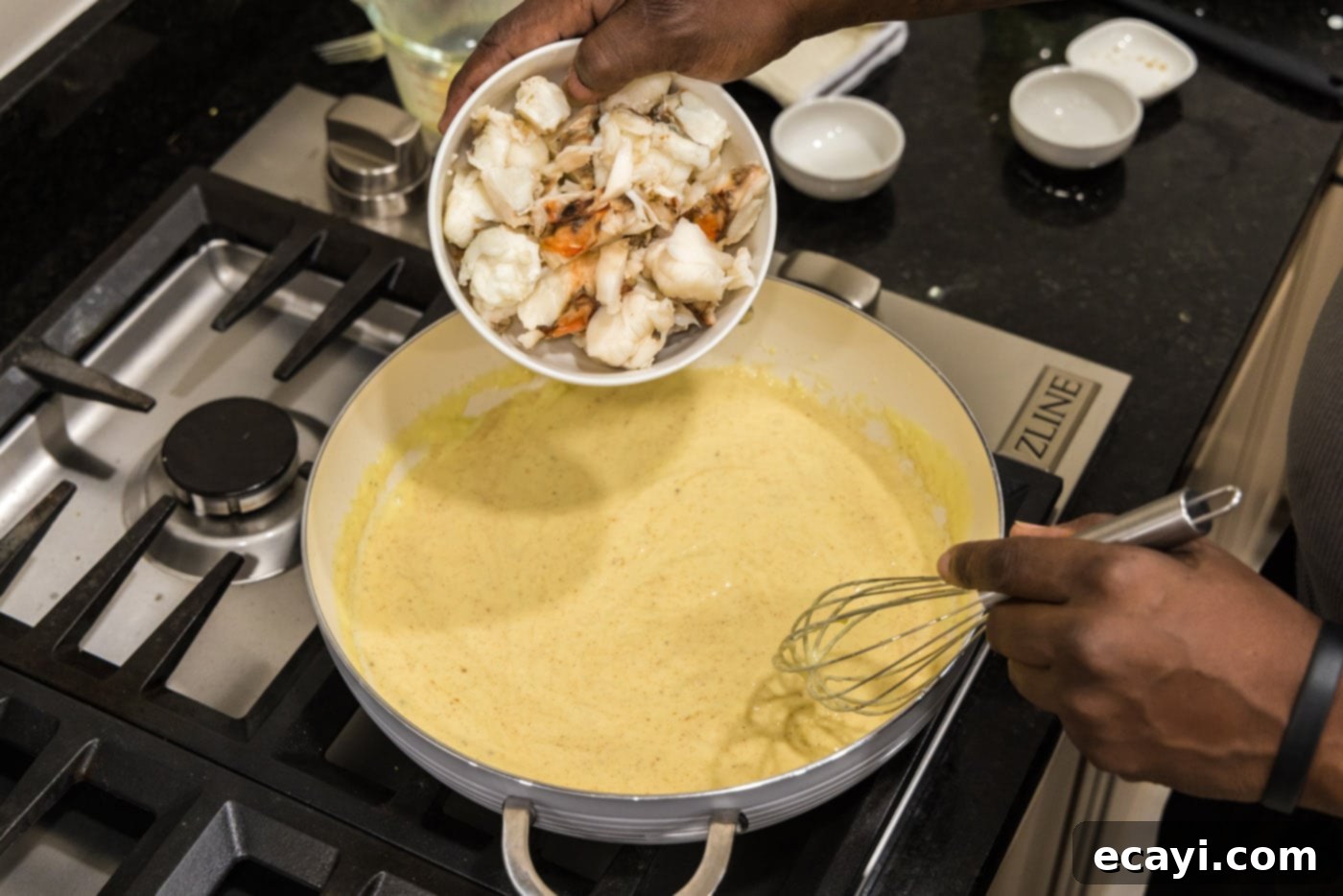
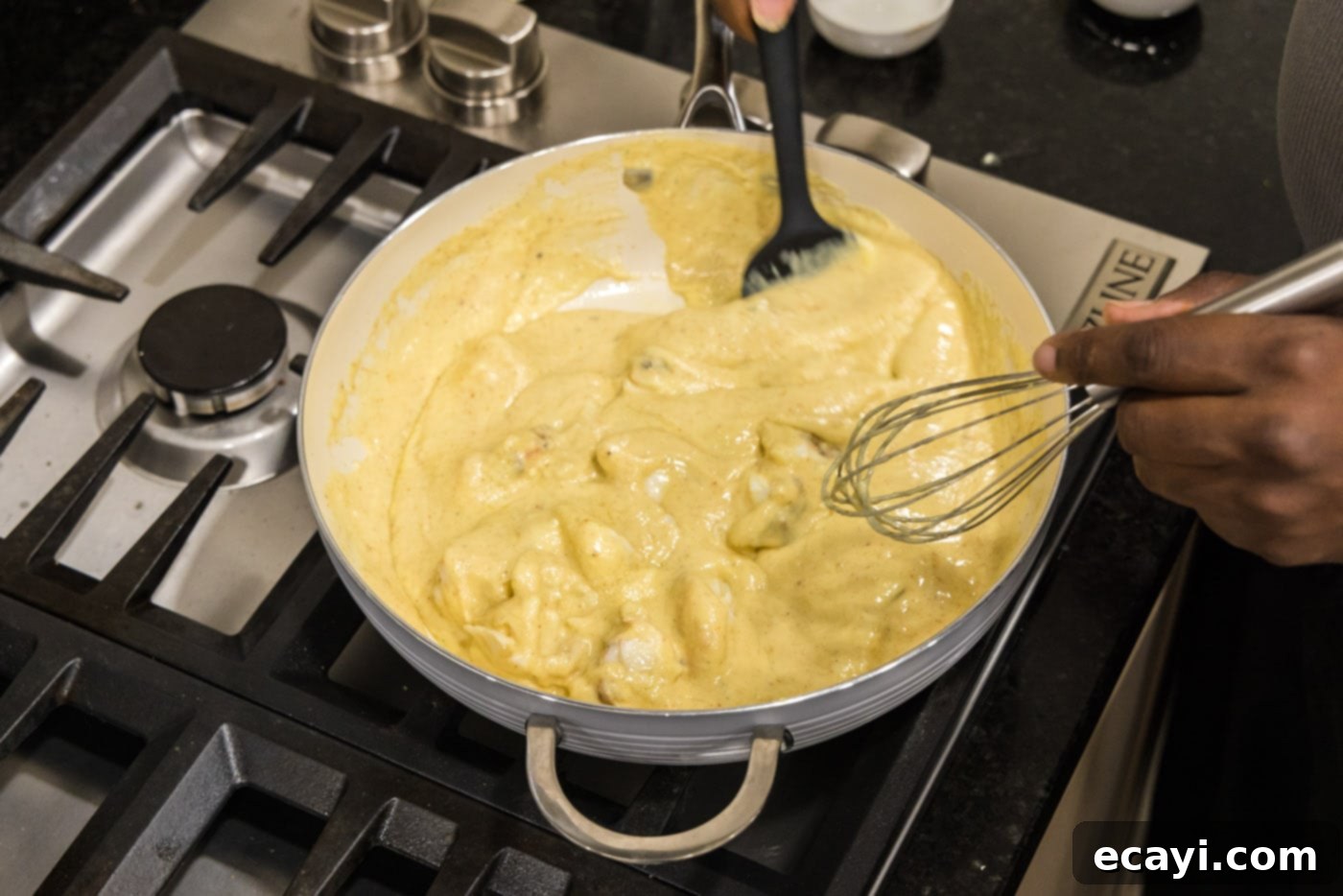
Frequently Asked Questions & Expert Tips for Perfect Lobster Newburg
Tempering is a crucial technique in cooking that involves gradually raising the temperature of a cold ingredient, like egg yolks, by slowly incorporating small amounts of hot liquid. The goal is to prevent the eggs from curdling or scrambling when added to a hot sauce or mixture. For this Lobster Newburg, you’ll slowly drizzle the egg and cream mixture into the hot skillet while continuously whisking. This allows the eggs to gently warm up and integrate seamlessly into the sauce, creating a smooth and emulsified consistency, rather than ending up with bits of scrambled egg.
While Lobster Newburg is best served fresh for optimal texture and flavor, you can prepare the lobster meat and the sauce separately a few hours in advance. Store the cooked lobster chunks in an airtight container in the refrigerator. Cool the sauce completely before storing it in a separate airtight container in the fridge. When ready to serve, gently reheat the sauce over low heat, whisking frequently. Once warm, carefully fold in the lobster chunks and heat just until warmed through. Be careful not to overcook the lobster during reheating.
Any leftover Lobster Newburg should be stored in an airtight container in the refrigerator and consumed within 1-2 days. Due to the rich dairy and delicate lobster, it doesn’t keep for very long. When reheating, use a gentle heat on the stovetop, stirring often, to prevent the sauce from breaking or the lobster from becoming tough.
Freezing Lobster Newburg is generally not recommended. The heavy cream sauce, once thawed, tends to separate and can become grainy or watery. The delicate texture of the lobster meat can also degrade upon freezing and thawing, becoming rubbery. It’s best enjoyed fresh.
For the most tender and flavorful results, we recommend using fresh, cold-water lobster tails, such as those from Maine or Canada. These tend to have a sweeter flavor and firmer texture. If fresh whole lobsters are available and you’re comfortable cooking them, that’s also an excellent option. For convenience, good quality frozen lobster tails (thawed properly) work well too.
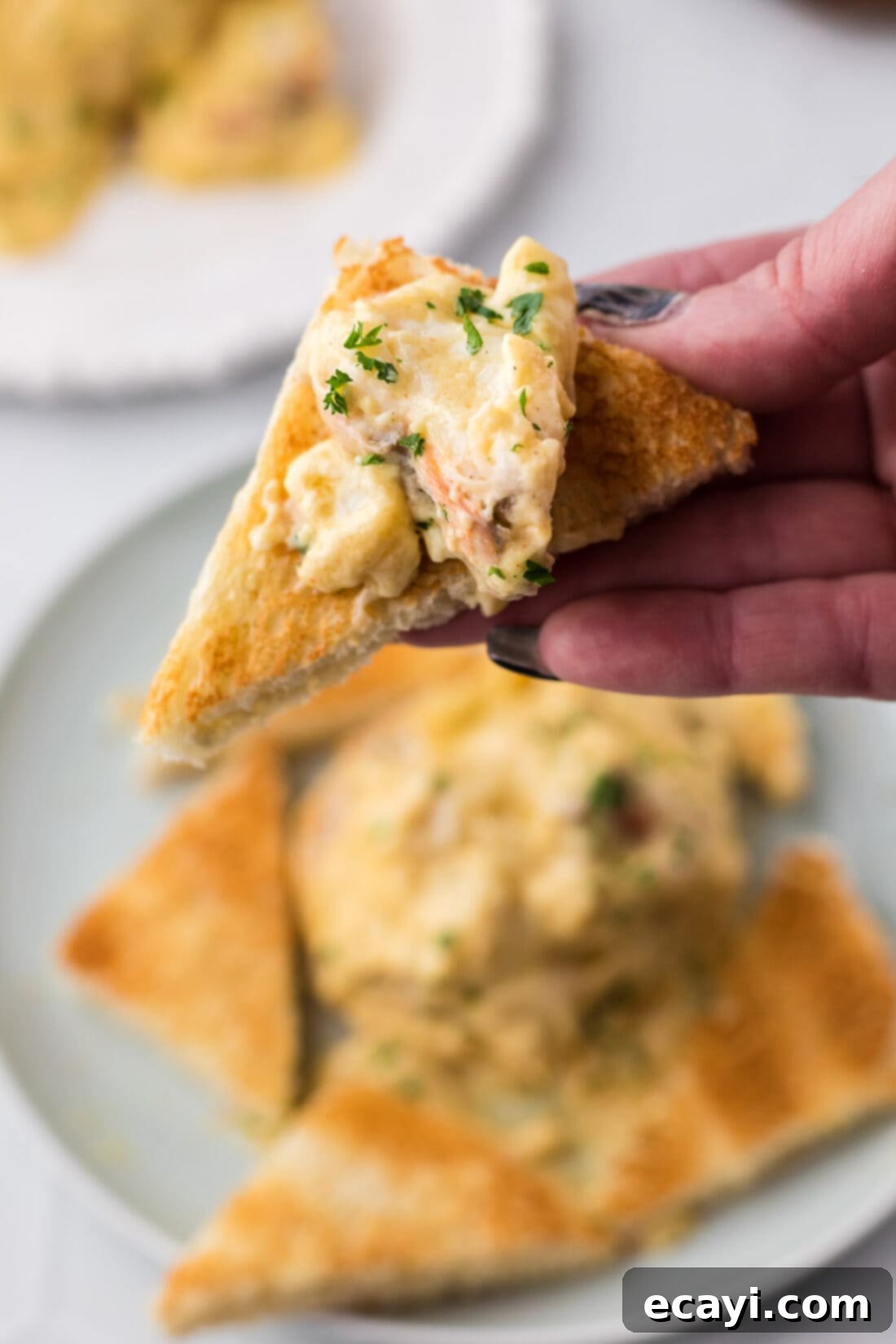
Elegant Serving Suggestions for Lobster Newburg
Lobster Newburg, with its luxurious appeal, offers versatile serving options, making it suitable for both casual and formal gatherings. It’s a dish that shines whether presented as a sophisticated appetizer or a lavish main course.
- Classic Presentation: Serve it simply in a beautiful ramekin or shallow dish, allowing the rich sauce and tender lobster to be the star.
- Over Carbs: The creamy sauce is perfect for soaking into various accompaniments.
- Biscuits: Fluffy, warm buttermilk biscuits are an exceptional choice, offering a comforting contrast to the rich sauce.
- Toast: Crisp, buttered toast points or brioche toast provide a delightful crunch and absorbent base.
- Flaky Pastry: For a truly elegant touch, serve in delicate vol-au-vent shells or over puff pastry squares.
- Rice: A bed of fluffy white rice, such as basmati or jasmine, is excellent for soaking up every drop of the delectable sauce.
- Pasta: Tossed with a delicate pasta like tagliatelle or fettuccine, it transforms into an incredibly rich seafood pasta dish.
- As an Appetizer: Serve smaller portions on crostini, in mini pastry cups, or in shot glasses for an upscale hors d’oeuvre.
- Side Dishes: Pair with light, complementary sides that won’t overshadow the lobster. A simple green salad with a vinaigrette, steamed asparagus, or tender-crisp green beans are excellent choices.
- Wine Pairing: A dry, crisp white wine such as Chardonnay (unoaked or lightly oaked), Sauvignon Blanc, or Pinot Grigio would beautifully complement the richness of the dish.
Explore More Decadent Lobster Recipes
If you have a passion for lobster, we have an array of other exquisite recipes that highlight this luxurious seafood:
- Lobster Bisque: A rich, creamy soup bursting with lobster flavor.
- Lobster Risotto: Creamy Arborio rice infused with sweet lobster and Parmesan.
- Lobster Thermidor: A classic baked lobster dish with a cheesy cream sauce.
- Lobster Mac and Cheese: The ultimate comfort food elevated with tender lobster chunks.
- Lobster Salad: A refreshing and light salad, perfect for sandwiches or lettuce wraps.
I love to bake and cook and share my kitchen experience with all of you! Remembering to come back each day can be tough, that’s why I offer a convenient newsletter every time a new recipe posts. Simply subscribe and start receiving your free daily recipes!
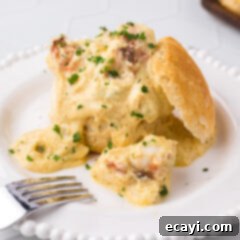
Lobster Newburg: An Indulgent Seafood Delight
IMPORTANT – There are often Frequently Asked Questions within the blog post that you may find helpful. Simply scroll back up to read them!
Print It
Pin It
Rate It
Save ItSaved!
Ingredients
- 1.25 pounds lobster (approximately 2 large tails, cooked and cut into chunks)
- 4 large egg yolks
- 3 cups heavy whipping cream (divided)
- ½ cup unsalted butter (8 Tablespoons)
- 1 Tablespoon minced garlic
- 1 Tablespoon all purpose flour
- 1 Tablespoon garlic salt
- 3 Tablespoons cognac (or substitute; see notes)
- ½ teaspoon ground nutmeg
- 1 teaspoon cayenne pepper
- 2 Tablespoons fresh lemon juice
Things You’ll Need
-
Large heavy bottomed skillet
-
Vinyl gloves (optional, for handling hot lobster)
Before You Begin & Expert Tips
- Find our detailed steamed lobster tail instructions here for perfectly cooked lobster every time.
- Sauce Consistency: The cream sauce mixture should be slightly thickened to coat the lobster beautifully. If it’s too thick, you can thin it with additional heavy cream or a splash of milk. If it’s too thin, let it simmer gently for a few more minutes to reduce, or whisk in a very small slurry of flour and cold water/cream.
- Cognac Substitutions: While cognac is a traditional ingredient, you can either omit it for a non-alcoholic version or substitute with brandy, dry sherry, a dry white wine, or a high-quality seafood stock in its place.
- Cayenne Pepper Heat: Although it seems like a generous amount, the heavy cream in this recipe significantly cuts down the perceived heat of the cayenne pepper, contributing a warm, subtle spice rather than overwhelming fieriness.
- Lower Calorie Option: To reduce the calorie and fat content, you can replace the heavy cream with whole milk. Please note this will result in a thinner sauce, and you may need to add a bit more flour to achieve the desired thickness. The overall richness and mouthfeel will also be lighter.
- Mastering Tempering: Tempering eggs is a critical step to ensure a smooth, uncurdled sauce. It involves slowly bringing the egg yolks up to temperature without scrambling them. This is achieved by gradually drizzling a small amount of the hot cream sauce into the whisked egg yolks and cream mixture, continuously whisking, before slowly adding this warmed egg mixture back into the main sauce. Constant whisking is absolutely key here to prevent any scrambling.
- Don’t Overcook the Lobster: Lobster meat can become tough and rubbery if cooked for too long. Ensure your lobster tails are just cooked through – opaque and firm, but still tender. Integrate them into the warm sauce only long enough to heat them through.
- Taste and Adjust: Always taste your sauce before serving and adjust seasonings (salt, pepper, lemon juice) as needed.
Instructions
-
Cook the lobster tails (you can follow our steamed lobster tail instructions for best results) and carefully cut the meat into bite-sized chunks. Set aside.
-
In a measuring cup or small bowl, add the 4 large egg yolks. Add 2 tablespoons of the heavy cream to the egg yolks and whisk thoroughly with a fork until smooth and combined.
-
Melt the ½ cup of butter in a large, heavy-bottomed skillet over medium-high heat until shimmering.
-
Add the 1 Tablespoon of minced garlic to the melted butter and sauté for 1 minute until fragrant. Stir in the 1 Tablespoon of all-purpose flour and cook, stirring constantly, for 1 minute to create a roux.
-
Add the 1 Tablespoon of garlic salt and stir well to combine it into the roux.
-
Gradually pour in the remaining heavy cream, whisking continuously to prevent lumps. Bring the mixture to a gentle boil, then immediately reduce the heat to low.
-
To temper the eggs, slowly drizzle a small amount of the hot cream mixture into the egg yolk mixture while whisking constantly. Then, slowly drizzle the warmed egg and cream mixture back into the hot skillet while continuing to whisk vigorously. This tempering process is essential to create a smooth, emulsified sauce without scrambling the eggs.
-
Whisk in the 3 Tablespoons of cognac (or substitute), ½ teaspoon of nutmeg, 1 teaspoon of cayenne pepper, and 2 Tablespoons of fresh lemon juice. Stir gently to combine all the flavors.
-
Add the cooked lobster chunks to the sauce and stir gently until they are thoroughly coated and just heated through. Do not overcook.
-
Serve this decadent Lobster Newburg immediately, either alone in a dish or elegantly over warm biscuits, crisp toast points, or delicate flaky pastry. Enjoy!
Nutrition
The recipes on this blog are tested with a conventional gas oven and gas stovetop. It’s important to note that some ovens, especially as they age, can cook and bake inconsistently. Using an inexpensive oven thermometer can assure you that your oven is truly heating to the proper temperature. If you use a toaster oven or countertop oven, please keep in mind that they may not distribute heat the same as a conventional full sized oven and you may need to adjust your cooking/baking times. In the case of recipes made with a pressure cooker, air fryer, slow cooker, or other appliance, a link to the appliances we use is listed within each respective recipe. For baking recipes where measurements are given by weight, please note that results may not be the same if cups are used instead, and we can’t guarantee success with that method.
